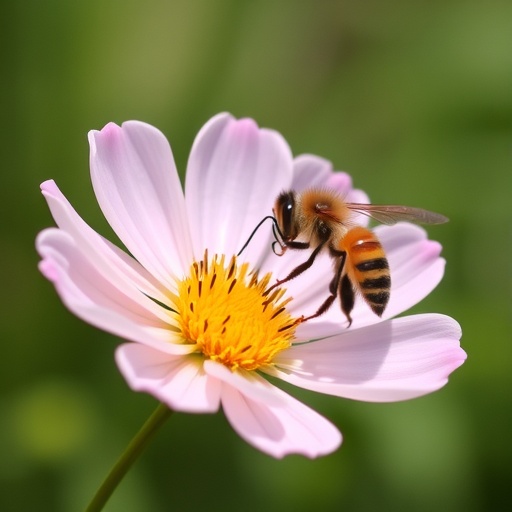In a groundbreaking study published in the esteemed journal ‘Scientific Nature’, researchers have delved into the complexities of how solitary pollinators, particularly bees, identify floral objects. The study posits that these creatures rely not solely on visual cues but also harness the power of olfactory signals, integrating the two sensory modalities in a sophisticated manner. This revelation opens new avenues for understanding pollinator behavior, necessitating a reevaluation of their sensory processing systems.
The research led by A. Mishra, alongside colleagues A. Jain and P.S. Iyer, presents empirical evidence supporting the hypothesis that solitary pollinators have evolved an intricate mechanism for floral object recognition. Throughout the study, the authors meticulously examined various species of solitary bees, documenting their responses to different flower types under controlled conditions. This innovative approach allowed researchers to isolate the responses attributable to visual stimuli from those elicited by olfactory cues, providing a clearer picture of how these insects navigate the floral landscape.
One of the most compelling findings of this research is the impact that florals’ color, shape, and scent have on the foraging behaviors of solitary bees. Notably, it became evident that these pollinators are capable of using visual cues, such as the vibrancy and patterns of flowers, to locate potential food sources. However, the researchers discovered that the olfactory signals emitted by flowers play an equally vital role, often serving as the initial attractant that leads bees to a particular flower. This dual-reliance on sensory information underscores the adaptability and sophistication of solitary bees.
In the various trials conducted, researchers observed how solitary bees exhibited distinct behavioral patterns when exposed to flowers with differing olfactory fragrances. By creating synthetic flowers that emitted specific scents, the study effectively demonstrated that bees were able to learn and remember olfactory cues associated with rewarding floral resources. This aspect of the study sheds light on the cognitive mapping abilities of these insects, suggesting that their memory plays a crucial role in enhancing foraging efficiency.
Moreover, this research highlights the critical relationship between flowering plants and their pollinators, emphasizing the role of fragrance as a key factor influencing this symbiotic relationship. Without the right olfactory cues, solitary bees may struggle to locate the nectar-rich blooms essential for their survival. This has broader implications for the health of ecosystems, particularly in the face of climate change and habitat destruction, which threatens to disrupt these intricate interactions.
Importantly, the implications of this study extend beyond mere academic curiosity. Understanding the mechanisms by which solitary pollinators identify floral objects has profound consequences for agricultural practices. As farmers seek to enhance pollination efficiency and improve crop yields, insights gleaned from this research could inform the design of more pollinator-friendly agricultural landscapes. Specifically, integrating pollen and nectar-rich plants could create an environment that nurtures these vital creatures, ultimately benefiting food production.
As solitary pollinators are vital for pollination services globally, the decline in their populations poses a significant concern for biodiversity and food security. Recent reports indicate that various species of bees are facing unprecedented threats from habitat loss, pesticide exposure, and climate change. The insights offered by Mishra et al.’s research could inform conservation strategies aimed at protecting these essential insects by enhancing our understanding of their foraging behaviors and needs.
Another notable aspect of the study is its exploration of the neural mechanisms these solitary bees employ in processing olfactory and visual cues. The findings suggest that there is a rich neural circuitry involved in integrating sensory inputs, which may allow for more effective decision-making during foraging. Further studies into the neurobiology of solitary pollinators are needed to unravel these complexities, potentially leading to advances in the fields of entomology and neuroethology.
The researchers also emphasized the importance of experimental design in studying animal behavior. By employing both field observations and laboratory experiments, the study achieved a comprehensive examination of solitary bees’ responses to floral stimuli. This methodological rigor not only strengthens the validity of the findings but also provides a template for future research investigating sensory processing in other pollinator species.
In conclusion, the research conducted by Mishra and colleagues marks a significant advance in our understanding of solitary pollinators and their interactions with floral environments. The integration of visual and olfactory cues in floral object identification reveals the sophisticated mechanisms underlying pollinator behavior and sheds light on the ecological roles these insects play. As researchers continue to explore these dynamics, it is crucial that policy-makers and agricultural stakeholders recognize the value of preserving both solitary and social pollinators.
The importance of maintaining the delicate balance between agricultural practices and ecological conservation cannot be overstated, especially as the health of ecosystems and food systems hangs in the balance. Future research should prioritize sustainable strategies that not only enhance agricultural productivity but also protect the biodiversity that underpins it.
As we seek to further unravel the mysteries of the natural world, studies like this serve as poignant reminders of the interconnectedness of species and the ecosystems they inhabit. The work of Mishra, Jain, and Iyer not only enriches the scientific community’s understanding of pollinators but also advocates for concerted efforts to protect and nurture these critical components of our environment.
Subject of Research: Floral object identification in solitary pollinators.
Article Title: Innate floral object identification in a solitary pollinator employs a combination of both visual and olfactory cues.
Article References:
Mishra, A., Jain, A., Iyer, P.S. et al. Innate floral object identification in a solitary pollinator employs a combination of both visual and olfactory cues.
Sci Nat 112, 18 (2025). https://doi.org/10.1007/s00114-025-01965-5
Image Credits: AI Generated
DOI: https://doi.org/10.1007/s00114-025-01965-5
Keywords: solitary pollinators, floral identification, visual cues, olfactory cues, bee behavior, ecological conservation, agricultural practices, sensory processing.




